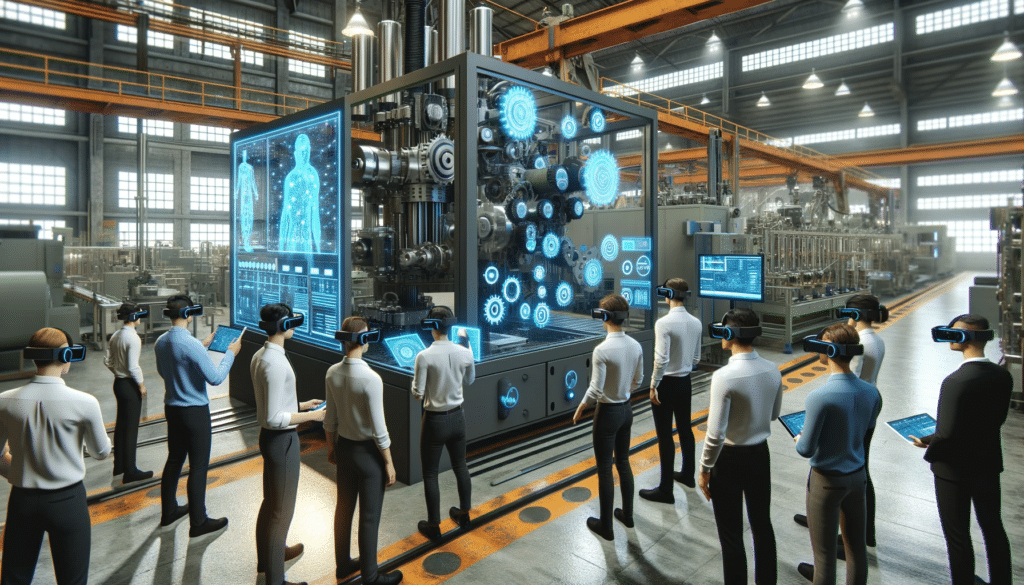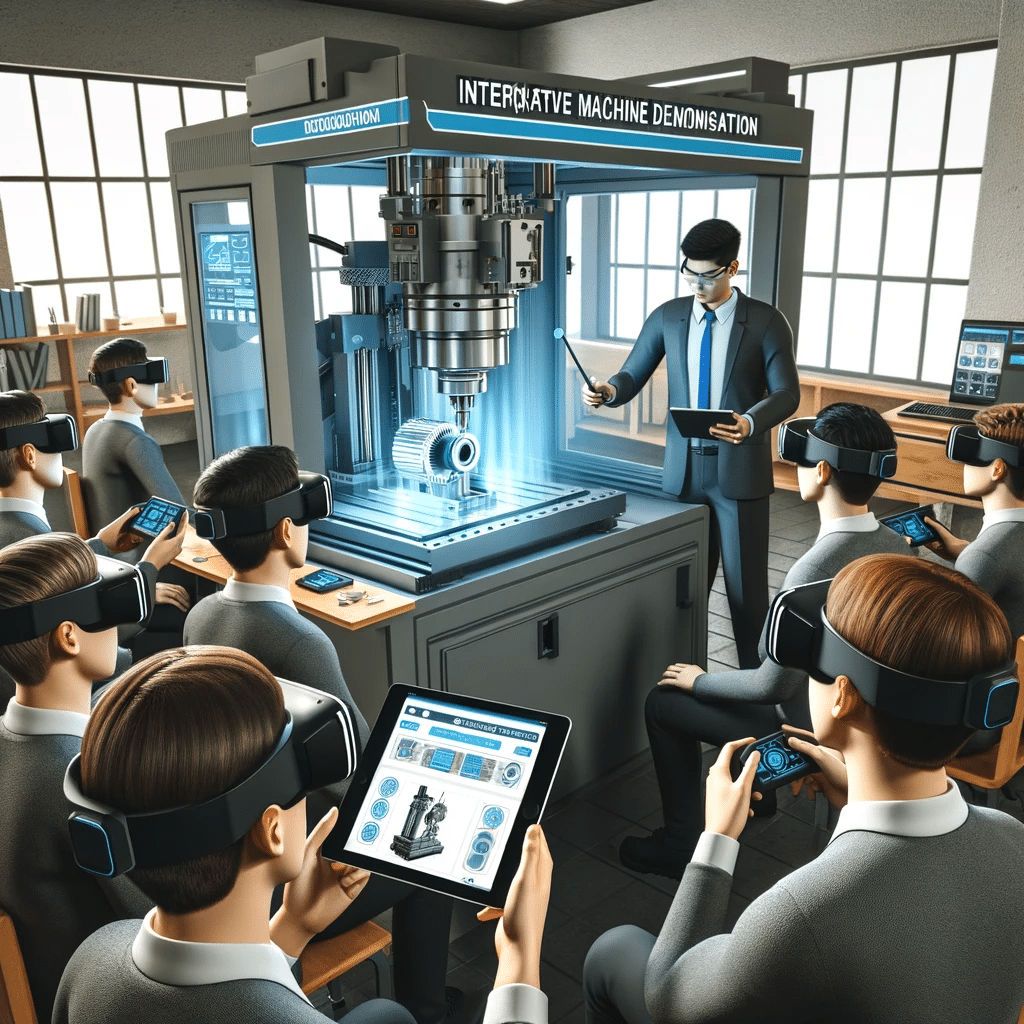Interactive machine demonstration: A guide to Industry 4.0
In a world that is rapidly moving towards digitalization and automation, the “Interactive Machine Demonstration” is at the heart of Industry 4.0. It is not only changing the way we look at and understand technology, but is also revolutionizing the way we learn and interact.
Overview
This article delves into the fascinating world of interactive machine demonstrations. We will explore what makes them tick, why they are essential in modern industry and how they fundamentally change the presentation and understanding of complex machines.
Objective
After reading this article, you will gain a comprehensive insight into the functionality, benefits and practical application of interactive machine demonstrations. You will also learn how these innovative technologies can be integrated into your company or educational institution to increase efficiency and improve the learning experience.

What are interactive machine demonstrations?
Interactive machine demonstrations are an advanced form of technology presentation where users gain a deeper understanding and hands-on experience with the machine or device through direct interaction. Unlike traditional demonstrations, which often only consist of passive observation, interactive demos allow users to interact directly with the machine, test its functions in real time and clarify questions in an immersive format.
This type of demonstration uses a combination of virtual reality (VR), augmented reality (AR) and sometimes mixed reality (MR) to create a fully immersive experience. Users can explore the machine in a safe, controlled environment, which is particularly beneficial for complex or dangerous machines.
The role of interactive demos in Industry 4.0
Industry 4.0 is characterized by networking, automation and data-driven decision-making. Interactive machine demonstrations play a key role in this context. They enable companies to present their technological advances in a way that is both informative and appealing. By blurring the boundaries between the physical and digital worlds, they offer a unique means of training employees, presenting product innovations and improving customer loyalty.
Interactive demos help to make complex machines and processes accessible to a wide audience. They make it possible to convey the functioning of a machine in detail without the viewer having to have any prior technical knowledge. This is particularly important for companies that manufacture or use complex products, as it enables them to make their technologies understandable to a wider audience.
Advantages of interactive machine demonstrations
The use of interactive machine demonstrations has a number of advantages. The most important of these include:
- Improved comprehensibility: Complex machines and processes can be simplified and made easier to understand using interactive elements.
- Higher engagement: Due to the interactive nature of the demos, participants are more active and engaged, leading to a deeper understanding and better recall of the content.
- Safety: Especially for dangerous or difficult-to-handle machines, interactive demos provide a safe environment for training and demonstration without risk to users or equipment.
Best practices for conducting an interactive demonstration
The successful implementation of an interactive machine demonstration requires careful planning and execution. Here are some best practices that can help:
- Define clear learning objectives: Determine in advance what the participants should take away from the demonstration. This helps to design a targeted and effective demo.
- Ensure user-friendliness: The technology should be intuitive and easy to use to enable a frustration-free learning experience.
- Encourage interaction: Encourage participants to ask questions and interact with the technology. This increases commitment and understanding.
- Obtain feedback: Use the participants’ feedback to continuously improve the demonstration.

Case studies: Successful examples from the industry
Case studies from companies that have successfully used interactive machine demonstrations can provide valuable insight and inspiration.
- Case study 1: A leading car manufacturer used interactive demos to demonstrate how its hybrid engines work. This not only helped with the internal training of employees, but also with the creation of a positive brand image with customers.
- Case study 2: A mechanical engineering company used VR demos to present complex machines in a virtual environment, which significantly increased sales.
These examples show how interactive demos can be used successfully across different sectors.
Mobile optimization
In today’s mobile world, it is essential that your interactive demonstration works smoothly on different devices. Mobile optimization ensures that users have an optimal experience regardless of their device. This includes responsive design elements, adaptation to different screen sizes and ensuring that interactive functions can also be operated intuitively on touchscreens.
Loading times
The loading time is a critical factor for the user experience. Optimize images, videos and other media elements to ensure fast loading times. This is particularly important as interactive machine demonstrations are often graphically more demanding. Use modern image formats and compression techniques to maintain the balance between quality and performance.
Promotion of commitment
Encourage your readers to interact with the post. This can be done by embedding surveys, comment areas or social media share buttons. Interactive elements in the article itself can further increase engagement and encourage readers to delve deeper into the topic.
Conversion elements
Strategically placed conversion elements such as newsletter registrations, contact forms or links to product pages can increase the conversion rate. These should be unobtrusive and provide added value for the reader in order to be effective.

Final tips
Quality over quantity
Focus on high-quality, unique content that offers real added value. Well-researched, informative content is much more effective than mere keyword optimization.
Actuality
Keep content up to date and update it regularly. This not only shows search engines that your website is alive, but also gives readers a reason to come back.
User Experience
Ensure a pleasant user experience. Good readability, appealing design and intuitive navigation contribute significantly to the overall quality of your contribution.
Summary
Interactive machine demonstrations offer a modern approach to communicating complex technologies. They are not only a tool for imparting knowledge, but also a means of increasing commitment and customer loyalty. With the right implementation, they can offer considerable added value for companies in various sectors.
If you are interested in integrating interactive technologies into your organization, start by evaluating existing resources and needs. Think about how such demos could enrich your business and don’t hesitate to contact experts for individual advice.
For a prime example and information on the use of 3D technologies in the industry, visit marconomy.de.
Find out more about klar.land’s machine demo at Interzum here.

Leave a Reply